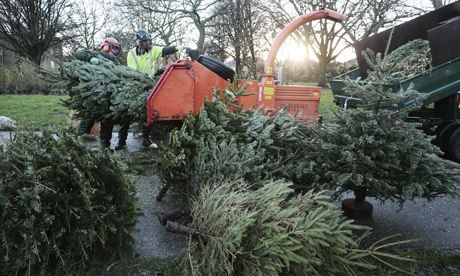Some rot in landfill, others are gobbled up by chipping machines to become compost or weed suppresant
Shorn of their baubles, tinsel and twinkling lights, the Christmas trees in a south-east London park have come to meet their end. “As long as this thing behaves itself, we could probably stick a hundred trees through it in an hour, it does eat them pretty quick,” says David Chapple of the bright orange chipper in front of him, as it gobbles up a tree sending a scent of pine into the air and a pile of woodchip into the waiting van.

Christmas tree recycling in Catford, Lewisham, south London. Photograph: Martin Godwin for the Guardian
The Norway spruce and Nordmann fir being chipped here in Mountsfield park are just a handful of the seven thousand or so that will be recycled in the borough of Lewisham in south London this year alone, up from fewer than two thousand a decade ago. This weekend many of the estimated 6-8 million ‘real’ trees bought by Britons each year will join them, as the 12 days of Christmas draw to a close.
A Nordmann fir, the ‘non-drop’ variety that was popularised over a decade ago and now accounts for around 80% of the Christmas trees bought in the UK, takes eight to 10 years to grow to 6ft. After its brief decorative turn in a festive front room, many are then flytipped rather than recycled. Altogether, the government’s waste agency Wrap estimates, that the nation’s dumped trees weigh in at around 160,000 tonnes.
If they end in landfill, each tree cost the local authority around £2.32 in fees and landfill taxes, according to the Local Government Association’s calculations. That figure will go up from April, when the price councils pay for every tonne of waste sent to landfill rises from £72 to £80.
Councillor Mike Jones, chair of the LGA’s environment and housing board, said: “Christmas can be an expensive time, but councils are helping to keep costs down through increasing the range of things which can be recycled to save money and minimising expensive landfill.”
It can take well into February to chip all of the Christmas trees in Lewisham, though trees have been dropped off as late as July. A lot are dropped by wholesalers, with their nets on – which slows down the chipping – while some left by householders are still adorned with baubles.
But the trees have a useful life after they have been shredded. Vanloads of the chippings are taken up to a nearby depot, where it is left to rot for months. “Then it goes back onto the beds, like those rose beds over there, mixed up with other tree waste, and works as a weed suppressant,” says Chapple.
While most are composted like this before being used on beds, some of the chippings go straight onto woodland paths, and some is processed before being used as soil conditioner. Some local authorities, such as Brighton & Hove, turn Christmas trees into soil conditioner that they then sell back to residents. Other councils give the bags of soil improver away.
If they do end up in landfill, trees have an environmental as well as economic cost. The Carbon Trust calculates the carbon footprint of a 2-metre tall at 16kg carbon dioxide equivalent because of the methane released as it decomposes (the average Briton’s carbon footprint is around 10,000kg).
But real trees still appear to be a greener choice than artificial ones, which would need to be kept for 10 years to be lower carbon, because of the oil the plastic would have been made with, according to the trust. A better option, for home-owners with space, is to have a potted living tree that they use year after year.
Unlike fake trees, real ones provide a habitat for wildlife too, says Harry Brightwell, secretary of the British Christmas Tree Growers Association. “You’ve got some people saying it’s not very green to chop down forests for Christmas trees. But they’re not realising it’s grown as a crop, and that it has wildlife including birds that live in them as they grow.”

